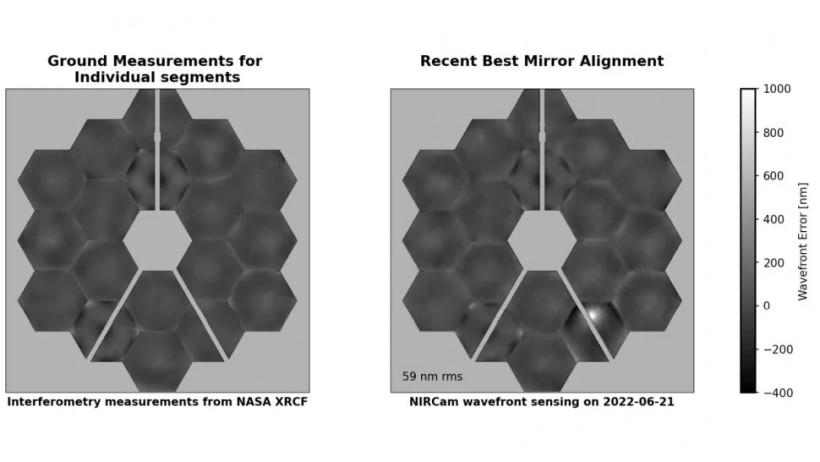The James Webb Space Telescope (JWST or simply Webb) may be performing better than expected now, but only time will tell.
Scientists from NASA, the European Space Agency (ESA), and the Canadian Space Agency (CSA) have recently released a report detailing the impact of the larger-than-usual micrometeoroid that damaged the telescope during the final stages of its commissioning process in late May.
NASA recently published photos taken by Webb, which can only be described as clear and sharp pictures of the many celestial bodies it took, including our very own Jupiter, despite the damage it sustained.
James Webb Space Telescope Damage Report Details

A picture of Webb's mirrors before (left) and after (right) the micrometeoroid impact. Notice the adjustments NASA made to the mirtrors to compensate for the damage.
According to the report scientists from NASA, ESA, and CSA wrote, the damage Webb sustained in early June had a minor effect on the space telescope, which is evidenced by the quality of the pictures it took.
However, while the damage's effect is small at present, there is no telling how bad it can affect Webb's future performance in the long run. This concern prompted engineers to figure out just how much of an impact the damage would cause on Webb's performance in the future.
You may remember that one of the telescope's 18 primary mirror segments was damaged by a micrometeoroid bigger than a grain of sand in late May, specifically its C3 segment. Although NASA's team stated that the telescope is still performing better than expected, the micrometeoroid's impact did affect its performance somewhat.
Read More: Chris Evans Still Prefers the iPhone 6S Despite Having an iPhone 12 Pro as His new Phone
The space agency noted a marginally detectable effect in the data the space telescope is sending back to Earth.
NASA also mentioned that micrometeoroids are "an unavoidable aspect" of operating any spacecraft due to them routinely sustaining many impacts from them throughout their lives in space.
NASA's Countermeasures Against Future Impacts
As such, NASA engineered Webb's mirrors to take impact from the micrometeoroid environment at its orbit around Sun-Earth L2 of dust-sized particles that fly at extreme velocities.
However, the report from NASA, ESA, and CSA's scientists mentioned that they aren't sure how much of an effect similar strikes will have on Webb's operations.
Additionally, engineers are still modeling the frequency of micrometeoroid strikes that will occur on the space telescope.
They will also model the population of hazardous micrometeoroids to estimate and create remedies to avoid them if Webb is more susceptible to damage by micrometeoroids. These remedies include restricting the telescope's pointing direction.
The team wrote that minimizing the amount of time Webb points directly into its orbital direction has a statistically higher chance of having the telescope encounter another micrometeoroid impact. As such, avoiding prolonged pointing in that direction could save the telescope's remaining mirrors from being damaged.
Nature mentioned in its report that engineers will be keeping an eye on potential future dust-generating events in the next two years, as they could create micrometeoroids that could put Webb in further danger than it could handle.
Interestingly, scientists expect that Halley's Comet could be seen from Earth during these two years, which could also lead to a dust-generating event.
Related Article: A 68GB SSD Allows James Webb Space Telescope to Record the Cosmos














